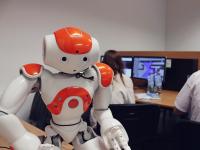How will a robot make life easier for older people and people with disabilities?
It will hand us a tea cup, check if we left the water running in the bathroom, or even jog our brain – these are just some of the tasks that a properly programmed robot can do. How do we reconcile limitless needs of a user with limited operational capabilities of a small robot?
Scientists from the Faculty of Electronics and Information Technology at the Warsaw University of Technology have been searching for a solution to this problem for 3 years of the RAPP project (Robotic Applications for Delivering Smart User Empowering Applications). The team under Prof. Cezary Zieliński, PhD (Eng) has conducted the project as part of the FP7 EU programme, together with international partners: Greece, Spain, France and the United Kingdom.
The goal of the project was to create a software platform facilitating the creation of applications for more universal and functional robots. Thanks to a better understanding of the owner’s intentions, these robots will be able to help older people and people with disabilities.
A Helping Hand
What’s special about this idea? After all, there are humanoid robots of the size of a human, which can successfully replace a housekeeper. The problem is that such robots are not only expensive, but they may also scare older people or people with disabilities.
Therefore, the project used robots available on the market that are relatively cheap, small, but also the ones that can’t be scary. They take many forms: a person having trouble with movement will need a robot that also fills the role of a walker. On the other hand, a person with memory problems will need a robot that can move efficiently in order to find the item they are looking for.
Needs vs Capabilities
“People treat such robots a bit like slaves”, Prof. Cezary Zieliński explains. “They think that machines can perform their every command. Our task was to find how to reconcile limited hardware resources ‘on board’ a small robot with limitless needs of a human”.
Thus engineers from the Warsaw University of Technology have created software that will enable cooperation of such electronic helpers with people. “The solution was to use cloud computing”, Prof. Zieliński explains. “Powerful servers host software that will provide the robot with all information necessary to efficiently react to a given task”.
Omniscient Helper
What is the path from issuing a command to the execution of a task? “A person addresses the robot verbally and it sends this request to the cloud where software appropriate for a given situation is selected”, Prof. Zieliński describes the outline of communication between a human and a robot. “This software is sent to the robot which installs and launches it”.
The robot does not actually know how to perform the task, but the module selected for a given situation does. This software takes over the control of the robot and guides it.
Technology Follows Social Needs
Our scientists were able to solve this tough problem and robots with access to specially prepared software underwent a series of laboratory tests. One of the Greek partners tested the suitability of the robots for people with mild dementia. The machine’s purpose was to train their mind, e.g. by asking questions about family members. A simple computer would suffice for such tasks; however, the elderly are often digitally excluded.
Furthermore, because most of the data necessary for such robot is kept in a cloud, we can create a user profile which will collect information about the user. The robot, interacting with its owner, will keep learning about him or her and saving behaviour patterns, preferences, needs. Each machine, although mass-produced, will in time become a personalized helper of a human. Even if it’s damaged, information collected about the user will be freely available to the next unit.
When Will Such Robots Become Common?
Soon it will be inevitable. “Because entire societies are ageing, developed countries lack workers, caregivers for older people”, Prof. Cezary Zieliński stresses. “It shows that we will be increasingly often able to solve social issues using technology”.
Monika Bukowska
Office for Promotion and Information








